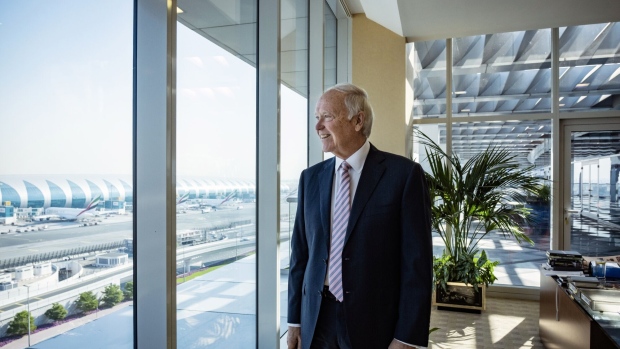Jan 8, 2024
Emirates’ Clark Says Blowout Illustrates Boeing’s Quality Lapses
, Bloomberg News

(Bloomberg) -- Emirates President Tim Clark, a powerful voice in the aviation community as the biggest buyer of widebody aircraft, said the accident on a Boeing Co. 737 Max aircraft on Jan. 5 marks a setback for the manufacturer just as it seeks to improve operations.
“They’ve had quality control problems for a long time now, and this is just another manifestation of that,” Clark said in an exclusive interview at his office in Dubai. “I think they’re getting their act together now, but this doesn’t help.”
While Emirates doesn’t fly the the Boeing 737 or the similar Airbus SE A320, Clark is known for holding both manufacturers and engine suppliers accountable for perceived engineering shortfalls.
At the same time, he acknowledged that there’s no option for airlines to go elsewhere for the time being, given the civil aviation world is essentially controlled by a duopoly. What Clark called “the wannabes” have got a lot of catching up to do if they want to be on equal footing with the two main players, he said.
Clark was speaking days after a Boeing 737 Max 9 aircraft operated by Alaska Airlines was forced into an emergency landing in Portland, Oregon, after a large panel broke loose during flight, leaving a gaping hole in the left part of the fuselage at 16,000 feet (4,900 meters). The aircraft returned safely and nobody was seriously injured, but regulators have ordered the grounding of the variant to perform inspections.
Shares Drop
The Emirates president has reserved some of his harshest recent criticism for engine maker Rolls-Royce Holdings Plc, saying it’s produced what he called a “defective” engine for Airbus’s largest aircraft, the A350-1000. By contrast, Emirates gave Boeing a glowing endorsement at the recent Dubai Air Show with a large order for the company’s wide-body aircraft.
Shares of Boeing fell 8.3% at 9:30 a.m. in New York, the biggest intraday decline since October 2022.
The latest scare with the 737 is all the more painful for Boeing because the aircraft has gone through a difficult few years, despite being the company’s biggest source of revenue. The 737 Max was grounded after two fatal accidents almost five years ago, and Boeing has recently grappled with manufacturing defects that have involved its biggest supplier, Spirit AeroSystems Holdings Inc.
The aircraft manufacturer has also previously struggled with production issues on its larger 787 Dreamliner model, which was a novel jet when it was first introduced because of its wide use of light-weight carbon composites. Boeing shook up the way it assembles the jet, relying in part on a network of partners — some overseas — to build components.
Read More: Boeing CEO’s Comeback Plan for 2024 Takes a Hit Five Days In (2)
While “Boeing has always produced very good airplanes,” Clark said there was “a plot loss” around some management decisions like moving the company’s head office and the way it “offshored across the world” on the 787.
Despite the furor surrounding the Alaska Airlines accident, Clark said “the good thing about it is that it’s solvable, salvageable.” Clark said he still has faith in Boeing and its ability to overcome the issues, provided management and the board of directors address the problems.
A lot will depend on finding out what caused the accident and determining the company’s role and ability to provide a fix, he said.
“If it was simple, a one-off, that’ll make life a lot easier for Boeing,” Clark said. “I think there’ll be a resolution fairly quickly.”
--With assistance from Jacqueline Simmons and John Micklethwait.
©2024 Bloomberg L.P.


